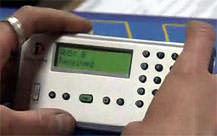Voting buttons – Kwik-Fit
“When we really looked into why 20% of our short-course learners weren’t passing, we realised that it wasn’t that they were failing to cope with the subject, they were just failing to cope with the tests. This took us on a journey that started with solving a dyslexia problem, but ended with a Who Wants to be a Millionaire type approach to assessment. Staff took to our new voting-button system straight away. We all had to invest a bit of time at the start, but now we find it really easy to use.
 The impact has been tremendous. Pretty much everyone passes now and the trainers like it to the point where we’d probably struggle without it – it’s become a tool very central to what we do.”
The impact has been tremendous. Pretty much everyone passes now and the trainers like it to the point where we’d probably struggle without it – it’s become a tool very central to what we do.”
Advice for others? “Refuse to allow people to fail. Do whatever it takes to support them to succeed.”
Steve Blount – technical trainer
‘Refuse to allow people to fail. Do whatever it takes to support them to succeed.’ This phrase captures Steve’s moral commitment to his learners, and it’s become the driving force for quality improvement.
 The Kwik-Fit training environment at the Derby academy is dominated by one-day and one-week courses. And with 1400 Kwik-Fit mechanics passing through the centre every quarter, a 20% failure rate was leaving the company under qualified and Steve and his team dissatisfied.
The Kwik-Fit training environment at the Derby academy is dominated by one-day and one-week courses. And with 1400 Kwik-Fit mechanics passing through the centre every quarter, a 20% failure rate was leaving the company under qualified and Steve and his team dissatisfied.
“I was aware that we’d had some dyslexic students who’d failed because they couldn’t read the test papers rather than because they didn’t know the subject”, recalls Steve. “So we had a day’s training from a consultant and began to make changes. One of the most significant of which was to use a sans serif font on a pastel background. And the easiest way to do this was to deliver the test using PowerPoint rather than paper – though learners still had to write their answers down.”
Achievement rates leapt to 95%. But the journey away from passing tests to being accredited for a level of understanding had only just begun – and Steve didn’t want any of his learners to fail.
 He was very aware that his staff were giving fairly standard off-the-shelf lessons irrespective of the learners’ abilities on entry. With hindsight, insufficient emphasis on initial and formative assessment meant that the trainers taught to the middle ground. In their review, Steve and his team considered the written assessments and verbal Q&A sessions used at the start of the course to be flawed – whilst being sufficient for confident learners, they were inappropriate for those who were not.
He was very aware that his staff were giving fairly standard off-the-shelf lessons irrespective of the learners’ abilities on entry. With hindsight, insufficient emphasis on initial and formative assessment meant that the trainers taught to the middle ground. In their review, Steve and his team considered the written assessments and verbal Q&A sessions used at the start of the course to be flawed – whilst being sufficient for confident learners, they were inappropriate for those who were not.
Management recognised the bottom-line impact of Steve’s initiatives and so set about searching for technology to help him reach the next stage – completely paperless assessment. They eventually invested in computer-based voting button system. Staff immediately engaged with the technology and whilst it did take a little time to get use to the interface, the program’s built-in PowerPoint function gave some immediate familiarity.
 With this simple approach, unconfident learners were no longer exposed by the assessment process, but could contribute risk-free at the press of a button – anonymous to all but the trainer. Initial and formative assessment then became fun.
With this simple approach, unconfident learners were no longer exposed by the assessment process, but could contribute risk-free at the press of a button – anonymous to all but the trainer. Initial and formative assessment then became fun.
Daniel Mundy, learner: “I hate writing answers down. With this, you press one button, press another button, and it’s done. It’s a lot easier.”
“We started by collecting together all of the questions we’d each used in our training,” says Steve, “and then set about writing more. That done, it was quite easy to build all of the quizzes we needed. We just had to:
- make a standard template (staying with the dyslexia-proof colours)
- type the questions and answers into the PowerPoint slides, and then
- set the parameters for each question, e.g. multi-choice, true/false, etc.
It takes just a matter of minutes, once you’re use to the interface.”
Initial assessment
 “We use the test at the start of all our courses, which are all either one-day or one-week block release. It’s a great ice-breaker as it gets all of the students involved straight away. But it’s more than that – in the past, if you asked an open question of the group, only the confident ones would answer. And the ones with no confidence could get locked into under-performing from then on. Worse still, we sometimes found ourselves asking the confident ones not to answer – but then we wouldn’t know whether they were getting it right or not, and it put an awkward pressure on the shy ones. The new system gets round all of these issues. I couldn’t train without it now. It’s so much easier and more effective. The system provides a level playing field – everyone gets to answer every question and, initially at least, it’s anonymous. This means they’ve got a secure environment in which to build their confidence and learn.”
“We use the test at the start of all our courses, which are all either one-day or one-week block release. It’s a great ice-breaker as it gets all of the students involved straight away. But it’s more than that – in the past, if you asked an open question of the group, only the confident ones would answer. And the ones with no confidence could get locked into under-performing from then on. Worse still, we sometimes found ourselves asking the confident ones not to answer – but then we wouldn’t know whether they were getting it right or not, and it put an awkward pressure on the shy ones. The new system gets round all of these issues. I couldn’t train without it now. It’s so much easier and more effective. The system provides a level playing field – everyone gets to answer every question and, initially at least, it’s anonymous. This means they’ve got a secure environment in which to build their confidence and learn.”
Formative assessment
![]() The trainers make notes on what learners get wrong in the first tests and adjust their training plans accordingly. This now means that courses are never delivered the same twice – they are always customised to meet the unique needs of each group. “The beauty is that I absolutely know whether they’re getting it or not,” says Steve, “so the chance of them getting to the final test and failing have all but gone.”
The trainers make notes on what learners get wrong in the first tests and adjust their training plans accordingly. This now means that courses are never delivered the same twice – they are always customised to meet the unique needs of each group. “The beauty is that I absolutely know whether they’re getting it or not,” says Steve, “so the chance of them getting to the final test and failing have all but gone.”
Learners enjoy using the Who Wants to be a Millionaire style voting buttons. Craig Hughes, student: “It doesn’t let you fall behind because it gives your instructor a chance to know that not everyone knows the answer.” Once all learners have selected what they feel is the most appropriate response, the results are shown as a bar chart on the main classroom data screen. If the answers given are not unanimous, the trainer uses the disagreement as an opportunity to revisit the learning point and reinforce the right answer through debate or illustration.
“On the longer programmes,” says Steve, “we can look across all of the quizzes each learner has taken to see how their understanding is developing. This helps us pick up on any individual support needs we might have missed and also acts as a check on our approach.”
Summative assessment
An added benefit of the system is the improved spirit in which the final test is taken. As the learners have used the voting button approach throughout the whole of their programme, “When they get to the final test that accredits them,” says Steve, “they’re no longer fazed by it.”
Systems
 Roger Smith, Technical Training Manager: “There are lots of different systems on the market and they all operate in slightly different ways. We picked the one that seemed best for our situation. It’s wasn’t expensive, which was great, so I would urge anybody who’s in a similar situation to us to have a play with these systems and see what they think. There’s also some very good free, open source technology such as Moodle which, in a networked computer suit, can produce the same sort of results.”
Roger Smith, Technical Training Manager: “There are lots of different systems on the market and they all operate in slightly different ways. We picked the one that seemed best for our situation. It’s wasn’t expensive, which was great, so I would urge anybody who’s in a similar situation to us to have a play with these systems and see what they think. There’s also some very good free, open source technology such as Moodle which, in a networked computer suit, can produce the same sort of results.”
Impact
When one of Kwik-Fit’s long-serving trainers was introduced to the voting buttons, with it’s very practical emphasis on initial, summative and formative assessment, he said to Steve afterwards that he’d suddenly realised how to become a trainer. But it wasn’t the technology that had inspired him, it was the sudden realisation that you have to check a learner’s understanding throughout the whole of their programme. His absolute confidence in knowing, at all times, what his learners had and hadn’t understood ensured that his sessions were never delivered the same twice and always met individuals’ needs. Little wonder that Kwik-Fit’s motor vehicle provision was given a grade 1, outstanding, in its inspection report. The key strengths inspectors highlighted were:
- excellent training resources
- strong company commitment to training
- particularly well planned and managed training programme.


